Mental Health and Education: A Discussion on the Short Film 'Alike'
VerifiedAdded on 2023/05/29
|10
|3145
|216
AI Summary
The number of young people experiencing a range of mental health issues is on the rise. Mental health should not be seen simply as absence of a diagnosable disease. Rather, there is a whole spectrum of mental health states that contribute to overall wellbeing.
Contribute Materials
Your contribution can guide someone’s learning journey. Share your
documents today.

Folio: Bringing it all into context
Secure Best Marks with AI Grader
Need help grading? Try our AI Grader for instant feedback on your assignments.
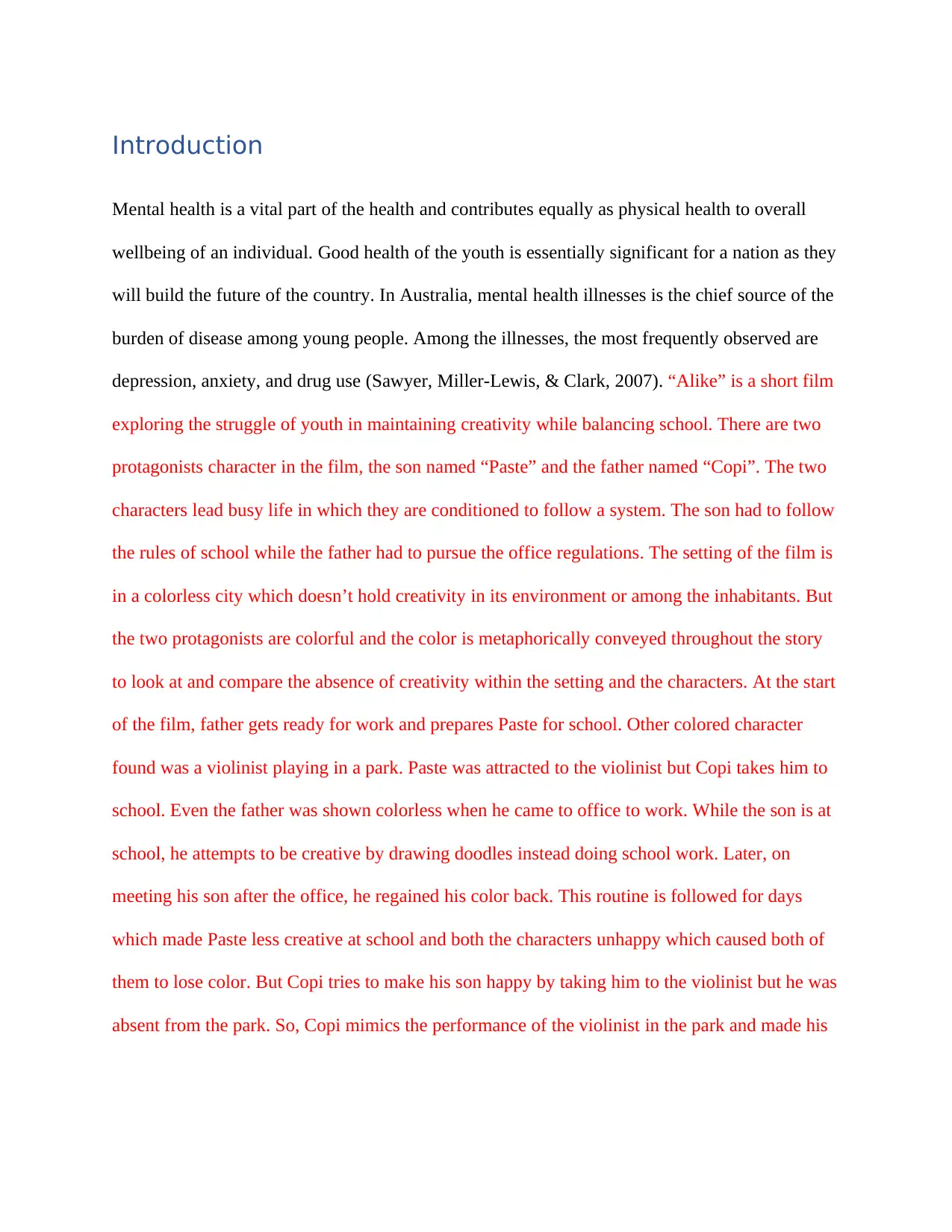
Introduction
Mental health is a vital part of the health and contributes equally as physical health to overall
wellbeing of an individual. Good health of the youth is essentially significant for a nation as they
will build the future of the country. In Australia, mental health illnesses is the chief source of the
burden of disease among young people. Among the illnesses, the most frequently observed are
depression, anxiety, and drug use (Sawyer, Miller-Lewis, & Clark, 2007). “Alike” is a short film
exploring the struggle of youth in maintaining creativity while balancing school. There are two
protagonists character in the film, the son named “Paste” and the father named “Copi”. The two
characters lead busy life in which they are conditioned to follow a system. The son had to follow
the rules of school while the father had to pursue the office regulations. The setting of the film is
in a colorless city which doesn’t hold creativity in its environment or among the inhabitants. But
the two protagonists are colorful and the color is metaphorically conveyed throughout the story
to look at and compare the absence of creativity within the setting and the characters. At the start
of the film, father gets ready for work and prepares Paste for school. Other colored character
found was a violinist playing in a park. Paste was attracted to the violinist but Copi takes him to
school. Even the father was shown colorless when he came to office to work. While the son is at
school, he attempts to be creative by drawing doodles instead doing school work. Later, on
meeting his son after the office, he regained his color back. This routine is followed for days
which made Paste less creative at school and both the characters unhappy which caused both of
them to lose color. But Copi tries to make his son happy by taking him to the violinist but he was
absent from the park. So, Copi mimics the performance of the violinist in the park and made his
Mental health is a vital part of the health and contributes equally as physical health to overall
wellbeing of an individual. Good health of the youth is essentially significant for a nation as they
will build the future of the country. In Australia, mental health illnesses is the chief source of the
burden of disease among young people. Among the illnesses, the most frequently observed are
depression, anxiety, and drug use (Sawyer, Miller-Lewis, & Clark, 2007). “Alike” is a short film
exploring the struggle of youth in maintaining creativity while balancing school. There are two
protagonists character in the film, the son named “Paste” and the father named “Copi”. The two
characters lead busy life in which they are conditioned to follow a system. The son had to follow
the rules of school while the father had to pursue the office regulations. The setting of the film is
in a colorless city which doesn’t hold creativity in its environment or among the inhabitants. But
the two protagonists are colorful and the color is metaphorically conveyed throughout the story
to look at and compare the absence of creativity within the setting and the characters. At the start
of the film, father gets ready for work and prepares Paste for school. Other colored character
found was a violinist playing in a park. Paste was attracted to the violinist but Copi takes him to
school. Even the father was shown colorless when he came to office to work. While the son is at
school, he attempts to be creative by drawing doodles instead doing school work. Later, on
meeting his son after the office, he regained his color back. This routine is followed for days
which made Paste less creative at school and both the characters unhappy which caused both of
them to lose color. But Copi tries to make his son happy by taking him to the violinist but he was
absent from the park. So, Copi mimics the performance of the violinist in the park and made his
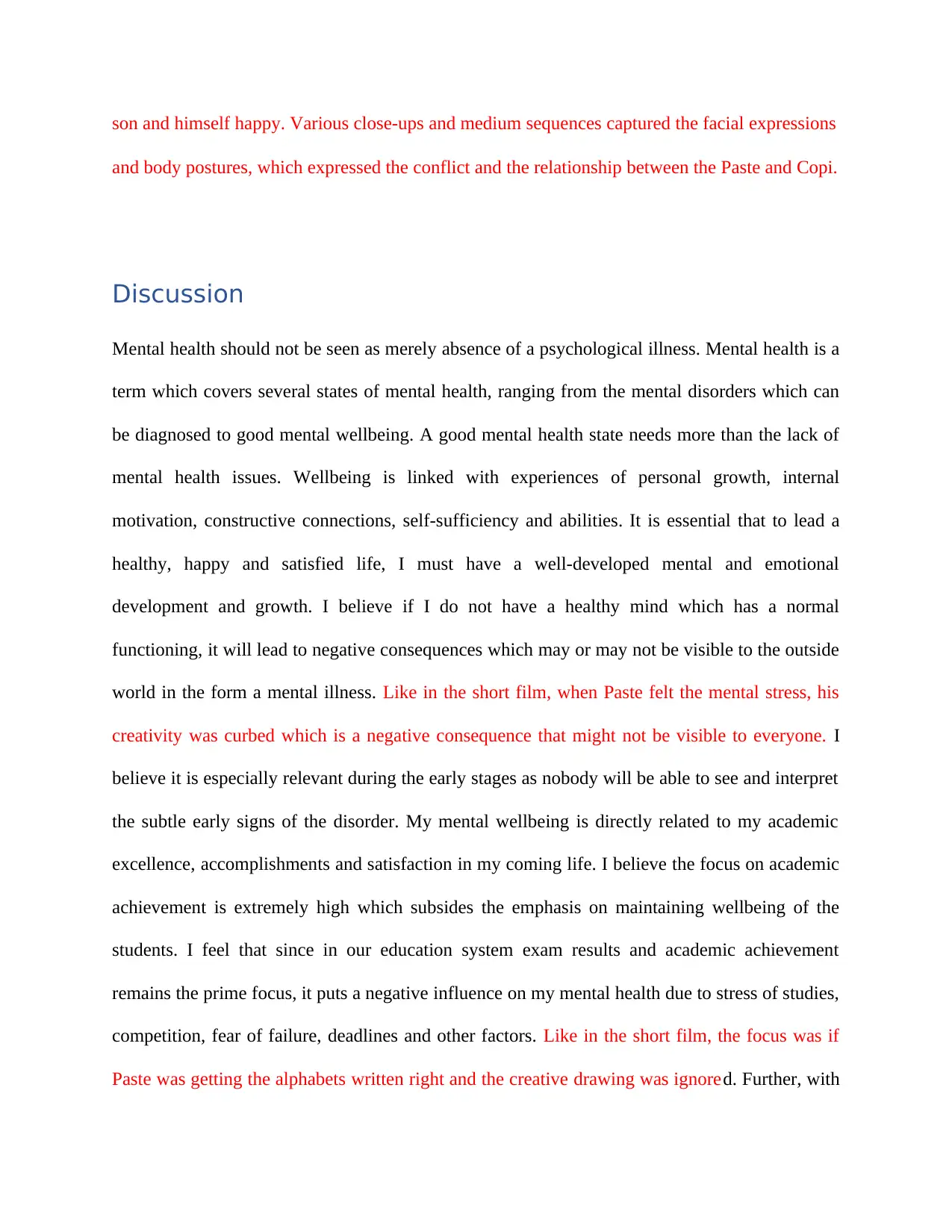
son and himself happy. Various close-ups and medium sequences captured the facial expressions
and body postures, which expressed the conflict and the relationship between the Paste and Copi.
Discussion
Mental health should not be seen as merely absence of a psychological illness. Mental health is a
term which covers several states of mental health, ranging from the mental disorders which can
be diagnosed to good mental wellbeing. A good mental health state needs more than the lack of
mental health issues. Wellbeing is linked with experiences of personal growth, internal
motivation, constructive connections, self-sufficiency and abilities. It is essential that to lead a
healthy, happy and satisfied life, I must have a well-developed mental and emotional
development and growth. I believe if I do not have a healthy mind which has a normal
functioning, it will lead to negative consequences which may or may not be visible to the outside
world in the form a mental illness. Like in the short film, when Paste felt the mental stress, his
creativity was curbed which is a negative consequence that might not be visible to everyone. I
believe it is especially relevant during the early stages as nobody will be able to see and interpret
the subtle early signs of the disorder. My mental wellbeing is directly related to my academic
excellence, accomplishments and satisfaction in my coming life. I believe the focus on academic
achievement is extremely high which subsides the emphasis on maintaining wellbeing of the
students. I feel that since in our education system exam results and academic achievement
remains the prime focus, it puts a negative influence on my mental health due to stress of studies,
competition, fear of failure, deadlines and other factors. Like in the short film, the focus was if
Paste was getting the alphabets written right and the creative drawing was ignored. Further, with
and body postures, which expressed the conflict and the relationship between the Paste and Copi.
Discussion
Mental health should not be seen as merely absence of a psychological illness. Mental health is a
term which covers several states of mental health, ranging from the mental disorders which can
be diagnosed to good mental wellbeing. A good mental health state needs more than the lack of
mental health issues. Wellbeing is linked with experiences of personal growth, internal
motivation, constructive connections, self-sufficiency and abilities. It is essential that to lead a
healthy, happy and satisfied life, I must have a well-developed mental and emotional
development and growth. I believe if I do not have a healthy mind which has a normal
functioning, it will lead to negative consequences which may or may not be visible to the outside
world in the form a mental illness. Like in the short film, when Paste felt the mental stress, his
creativity was curbed which is a negative consequence that might not be visible to everyone. I
believe it is especially relevant during the early stages as nobody will be able to see and interpret
the subtle early signs of the disorder. My mental wellbeing is directly related to my academic
excellence, accomplishments and satisfaction in my coming life. I believe the focus on academic
achievement is extremely high which subsides the emphasis on maintaining wellbeing of the
students. I feel that since in our education system exam results and academic achievement
remains the prime focus, it puts a negative influence on my mental health due to stress of studies,
competition, fear of failure, deadlines and other factors. Like in the short film, the focus was if
Paste was getting the alphabets written right and the creative drawing was ignored. Further, with
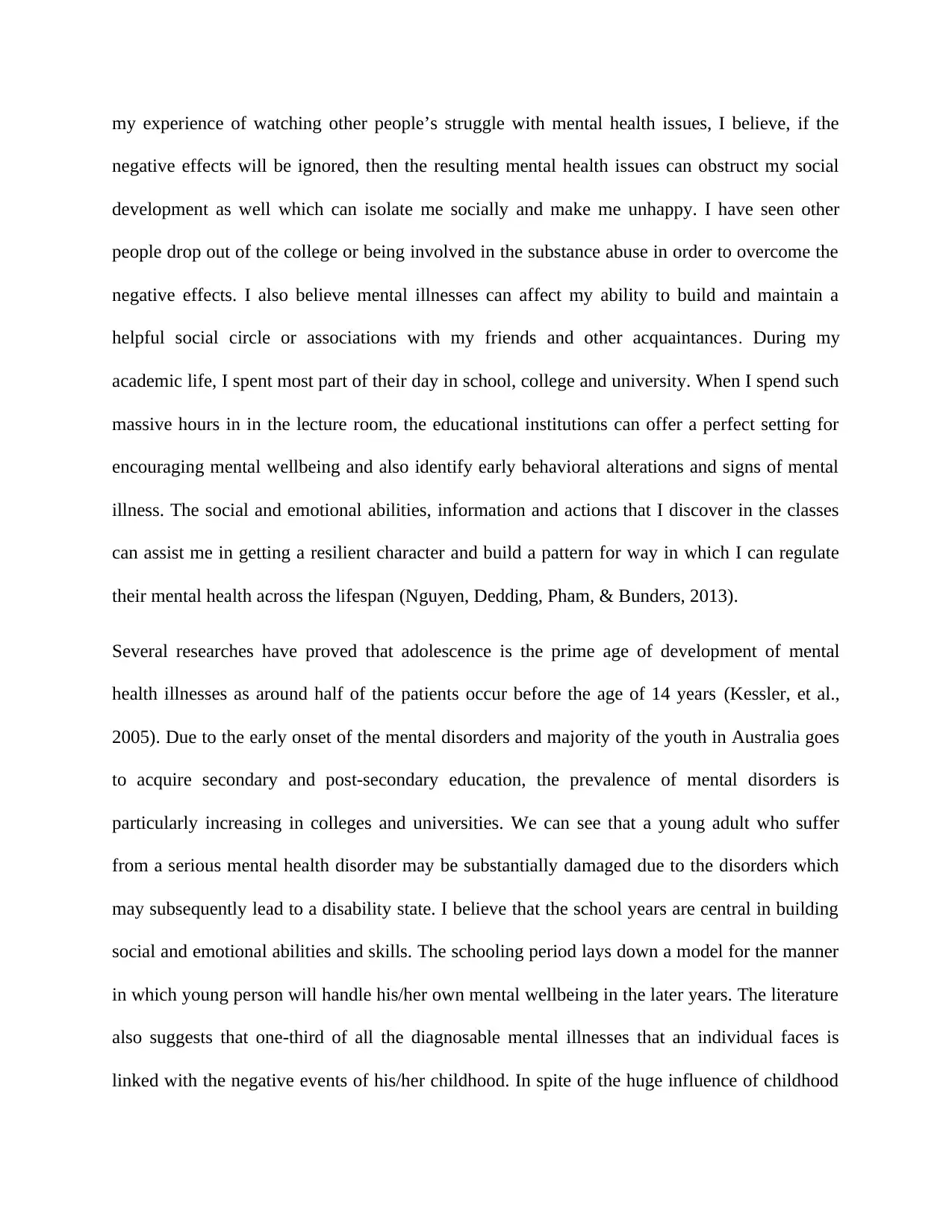
my experience of watching other people’s struggle with mental health issues, I believe, if the
negative effects will be ignored, then the resulting mental health issues can obstruct my social
development as well which can isolate me socially and make me unhappy. I have seen other
people drop out of the college or being involved in the substance abuse in order to overcome the
negative effects. I also believe mental illnesses can affect my ability to build and maintain a
helpful social circle or associations with my friends and other acquaintances. During my
academic life, I spent most part of their day in school, college and university. When I spend such
massive hours in in the lecture room, the educational institutions can offer a perfect setting for
encouraging mental wellbeing and also identify early behavioral alterations and signs of mental
illness. The social and emotional abilities, information and actions that I discover in the classes
can assist me in getting a resilient character and build a pattern for way in which I can regulate
their mental health across the lifespan (Nguyen, Dedding, Pham, & Bunders, 2013).
Several researches have proved that adolescence is the prime age of development of mental
health illnesses as around half of the patients occur before the age of 14 years (Kessler, et al.,
2005). Due to the early onset of the mental disorders and majority of the youth in Australia goes
to acquire secondary and post-secondary education, the prevalence of mental disorders is
particularly increasing in colleges and universities. We can see that a young adult who suffer
from a serious mental health disorder may be substantially damaged due to the disorders which
may subsequently lead to a disability state. I believe that the school years are central in building
social and emotional abilities and skills. The schooling period lays down a model for the manner
in which young person will handle his/her own mental wellbeing in the later years. The literature
also suggests that one-third of all the diagnosable mental illnesses that an individual faces is
linked with the negative events of his/her childhood. In spite of the huge influence of childhood
negative effects will be ignored, then the resulting mental health issues can obstruct my social
development as well which can isolate me socially and make me unhappy. I have seen other
people drop out of the college or being involved in the substance abuse in order to overcome the
negative effects. I also believe mental illnesses can affect my ability to build and maintain a
helpful social circle or associations with my friends and other acquaintances. During my
academic life, I spent most part of their day in school, college and university. When I spend such
massive hours in in the lecture room, the educational institutions can offer a perfect setting for
encouraging mental wellbeing and also identify early behavioral alterations and signs of mental
illness. The social and emotional abilities, information and actions that I discover in the classes
can assist me in getting a resilient character and build a pattern for way in which I can regulate
their mental health across the lifespan (Nguyen, Dedding, Pham, & Bunders, 2013).
Several researches have proved that adolescence is the prime age of development of mental
health illnesses as around half of the patients occur before the age of 14 years (Kessler, et al.,
2005). Due to the early onset of the mental disorders and majority of the youth in Australia goes
to acquire secondary and post-secondary education, the prevalence of mental disorders is
particularly increasing in colleges and universities. We can see that a young adult who suffer
from a serious mental health disorder may be substantially damaged due to the disorders which
may subsequently lead to a disability state. I believe that the school years are central in building
social and emotional abilities and skills. The schooling period lays down a model for the manner
in which young person will handle his/her own mental wellbeing in the later years. The literature
also suggests that one-third of all the diagnosable mental illnesses that an individual faces is
linked with the negative events of his/her childhood. In spite of the huge influence of childhood
Paraphrase This Document
Need a fresh take? Get an instant paraphrase of this document with our AI Paraphraser
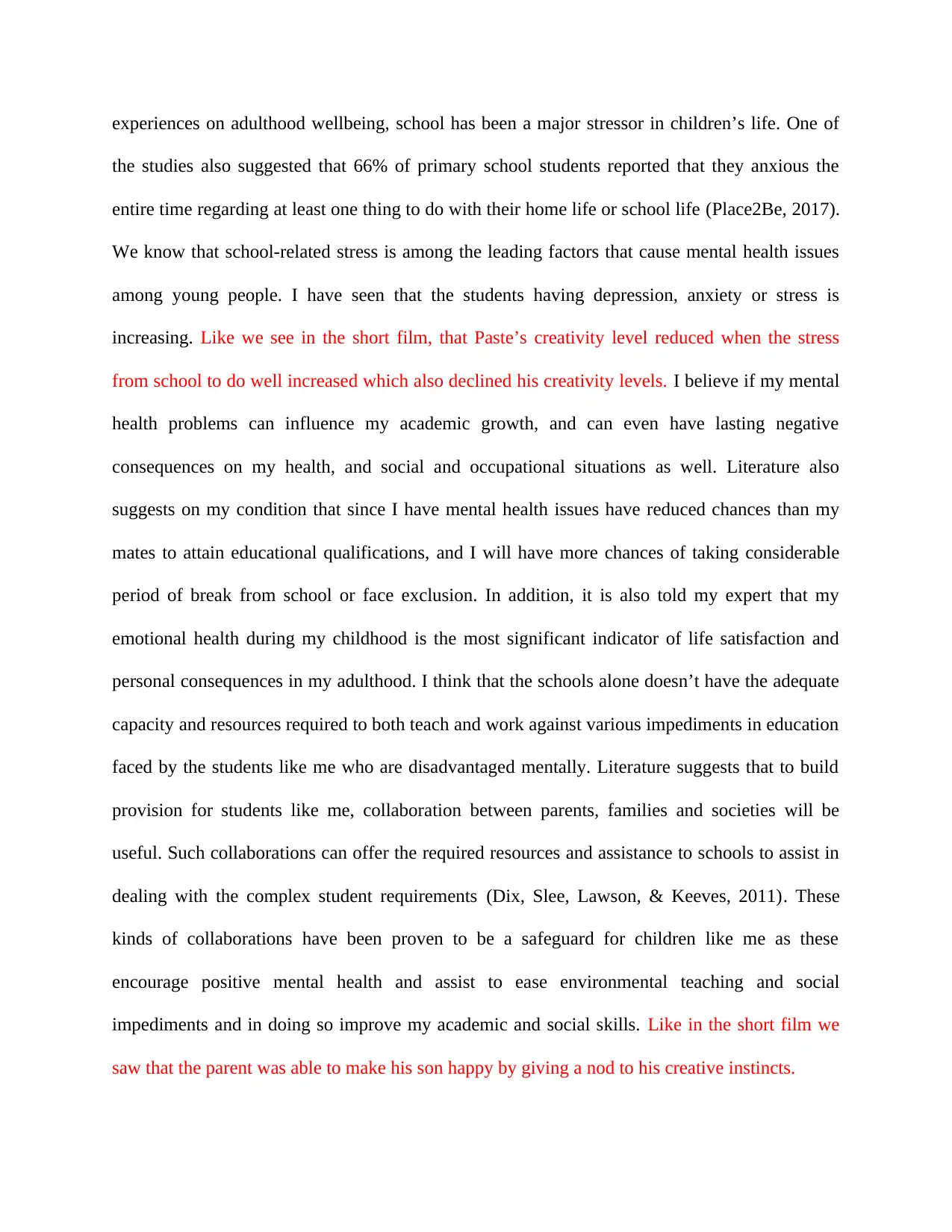
experiences on adulthood wellbeing, school has been a major stressor in children’s life. One of
the studies also suggested that 66% of primary school students reported that they anxious the
entire time regarding at least one thing to do with their home life or school life (Place2Be, 2017).
We know that school-related stress is among the leading factors that cause mental health issues
among young people. I have seen that the students having depression, anxiety or stress is
increasing. Like we see in the short film, that Paste’s creativity level reduced when the stress
from school to do well increased which also declined his creativity levels. I believe if my mental
health problems can influence my academic growth, and can even have lasting negative
consequences on my health, and social and occupational situations as well. Literature also
suggests on my condition that since I have mental health issues have reduced chances than my
mates to attain educational qualifications, and I will have more chances of taking considerable
period of break from school or face exclusion. In addition, it is also told my expert that my
emotional health during my childhood is the most significant indicator of life satisfaction and
personal consequences in my adulthood. I think that the schools alone doesn’t have the adequate
capacity and resources required to both teach and work against various impediments in education
faced by the students like me who are disadvantaged mentally. Literature suggests that to build
provision for students like me, collaboration between parents, families and societies will be
useful. Such collaborations can offer the required resources and assistance to schools to assist in
dealing with the complex student requirements (Dix, Slee, Lawson, & Keeves, 2011). These
kinds of collaborations have been proven to be a safeguard for children like me as these
encourage positive mental health and assist to ease environmental teaching and social
impediments and in doing so improve my academic and social skills. Like in the short film we
saw that the parent was able to make his son happy by giving a nod to his creative instincts.
the studies also suggested that 66% of primary school students reported that they anxious the
entire time regarding at least one thing to do with their home life or school life (Place2Be, 2017).
We know that school-related stress is among the leading factors that cause mental health issues
among young people. I have seen that the students having depression, anxiety or stress is
increasing. Like we see in the short film, that Paste’s creativity level reduced when the stress
from school to do well increased which also declined his creativity levels. I believe if my mental
health problems can influence my academic growth, and can even have lasting negative
consequences on my health, and social and occupational situations as well. Literature also
suggests on my condition that since I have mental health issues have reduced chances than my
mates to attain educational qualifications, and I will have more chances of taking considerable
period of break from school or face exclusion. In addition, it is also told my expert that my
emotional health during my childhood is the most significant indicator of life satisfaction and
personal consequences in my adulthood. I think that the schools alone doesn’t have the adequate
capacity and resources required to both teach and work against various impediments in education
faced by the students like me who are disadvantaged mentally. Literature suggests that to build
provision for students like me, collaboration between parents, families and societies will be
useful. Such collaborations can offer the required resources and assistance to schools to assist in
dealing with the complex student requirements (Dix, Slee, Lawson, & Keeves, 2011). These
kinds of collaborations have been proven to be a safeguard for children like me as these
encourage positive mental health and assist to ease environmental teaching and social
impediments and in doing so improve my academic and social skills. Like in the short film we
saw that the parent was able to make his son happy by giving a nod to his creative instincts.
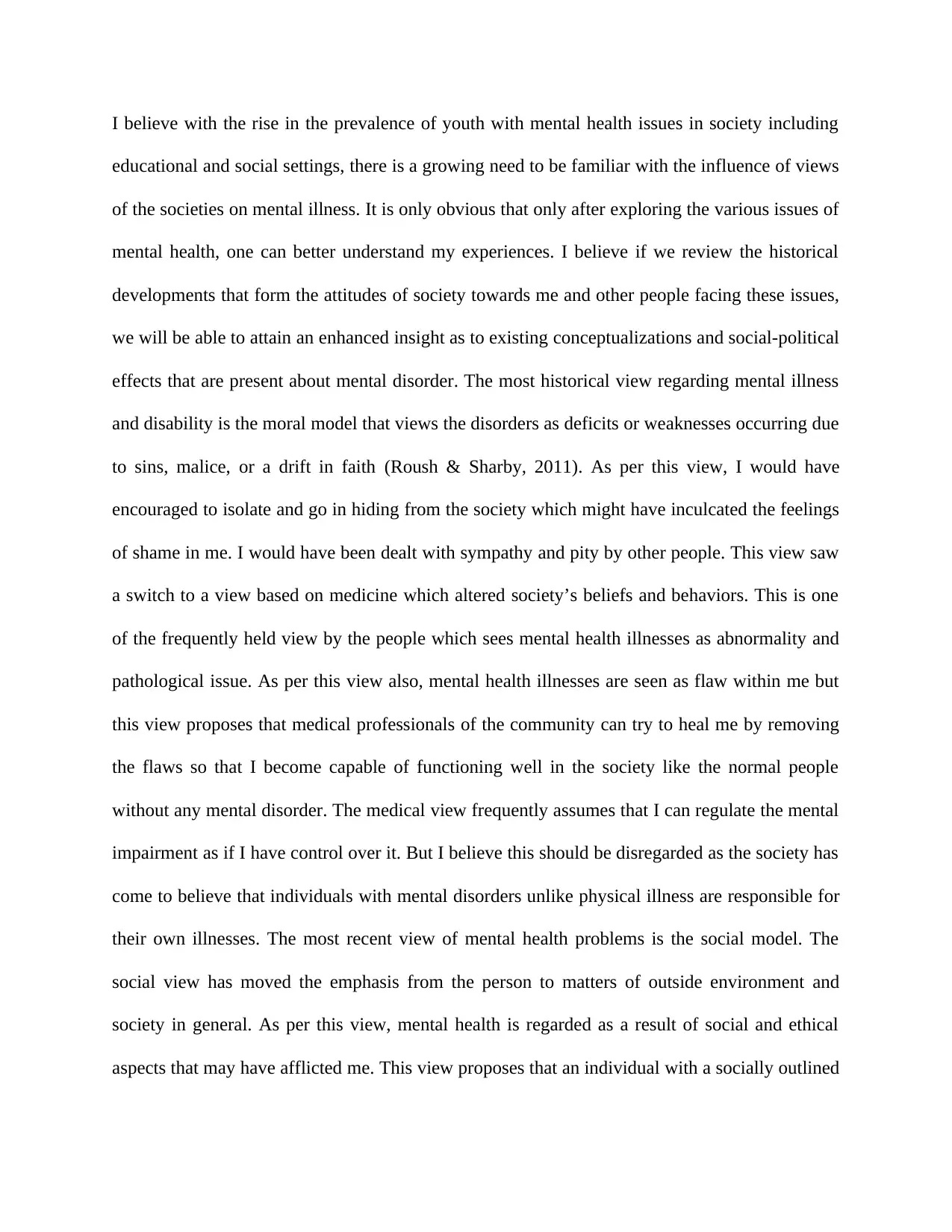
I believe with the rise in the prevalence of youth with mental health issues in society including
educational and social settings, there is a growing need to be familiar with the influence of views
of the societies on mental illness. It is only obvious that only after exploring the various issues of
mental health, one can better understand my experiences. I believe if we review the historical
developments that form the attitudes of society towards me and other people facing these issues,
we will be able to attain an enhanced insight as to existing conceptualizations and social-political
effects that are present about mental disorder. The most historical view regarding mental illness
and disability is the moral model that views the disorders as deficits or weaknesses occurring due
to sins, malice, or a drift in faith (Roush & Sharby, 2011). As per this view, I would have
encouraged to isolate and go in hiding from the society which might have inculcated the feelings
of shame in me. I would have been dealt with sympathy and pity by other people. This view saw
a switch to a view based on medicine which altered society’s beliefs and behaviors. This is one
of the frequently held view by the people which sees mental health illnesses as abnormality and
pathological issue. As per this view also, mental health illnesses are seen as flaw within me but
this view proposes that medical professionals of the community can try to heal me by removing
the flaws so that I become capable of functioning well in the society like the normal people
without any mental disorder. The medical view frequently assumes that I can regulate the mental
impairment as if I have control over it. But I believe this should be disregarded as the society has
come to believe that individuals with mental disorders unlike physical illness are responsible for
their own illnesses. The most recent view of mental health problems is the social model. The
social view has moved the emphasis from the person to matters of outside environment and
society in general. As per this view, mental health is regarded as a result of social and ethical
aspects that may have afflicted me. This view proposes that an individual with a socially outlined
educational and social settings, there is a growing need to be familiar with the influence of views
of the societies on mental illness. It is only obvious that only after exploring the various issues of
mental health, one can better understand my experiences. I believe if we review the historical
developments that form the attitudes of society towards me and other people facing these issues,
we will be able to attain an enhanced insight as to existing conceptualizations and social-political
effects that are present about mental disorder. The most historical view regarding mental illness
and disability is the moral model that views the disorders as deficits or weaknesses occurring due
to sins, malice, or a drift in faith (Roush & Sharby, 2011). As per this view, I would have
encouraged to isolate and go in hiding from the society which might have inculcated the feelings
of shame in me. I would have been dealt with sympathy and pity by other people. This view saw
a switch to a view based on medicine which altered society’s beliefs and behaviors. This is one
of the frequently held view by the people which sees mental health illnesses as abnormality and
pathological issue. As per this view also, mental health illnesses are seen as flaw within me but
this view proposes that medical professionals of the community can try to heal me by removing
the flaws so that I become capable of functioning well in the society like the normal people
without any mental disorder. The medical view frequently assumes that I can regulate the mental
impairment as if I have control over it. But I believe this should be disregarded as the society has
come to believe that individuals with mental disorders unlike physical illness are responsible for
their own illnesses. The most recent view of mental health problems is the social model. The
social view has moved the emphasis from the person to matters of outside environment and
society in general. As per this view, mental health is regarded as a result of social and ethical
aspects that may have afflicted me. This view proposes that an individual with a socially outlined
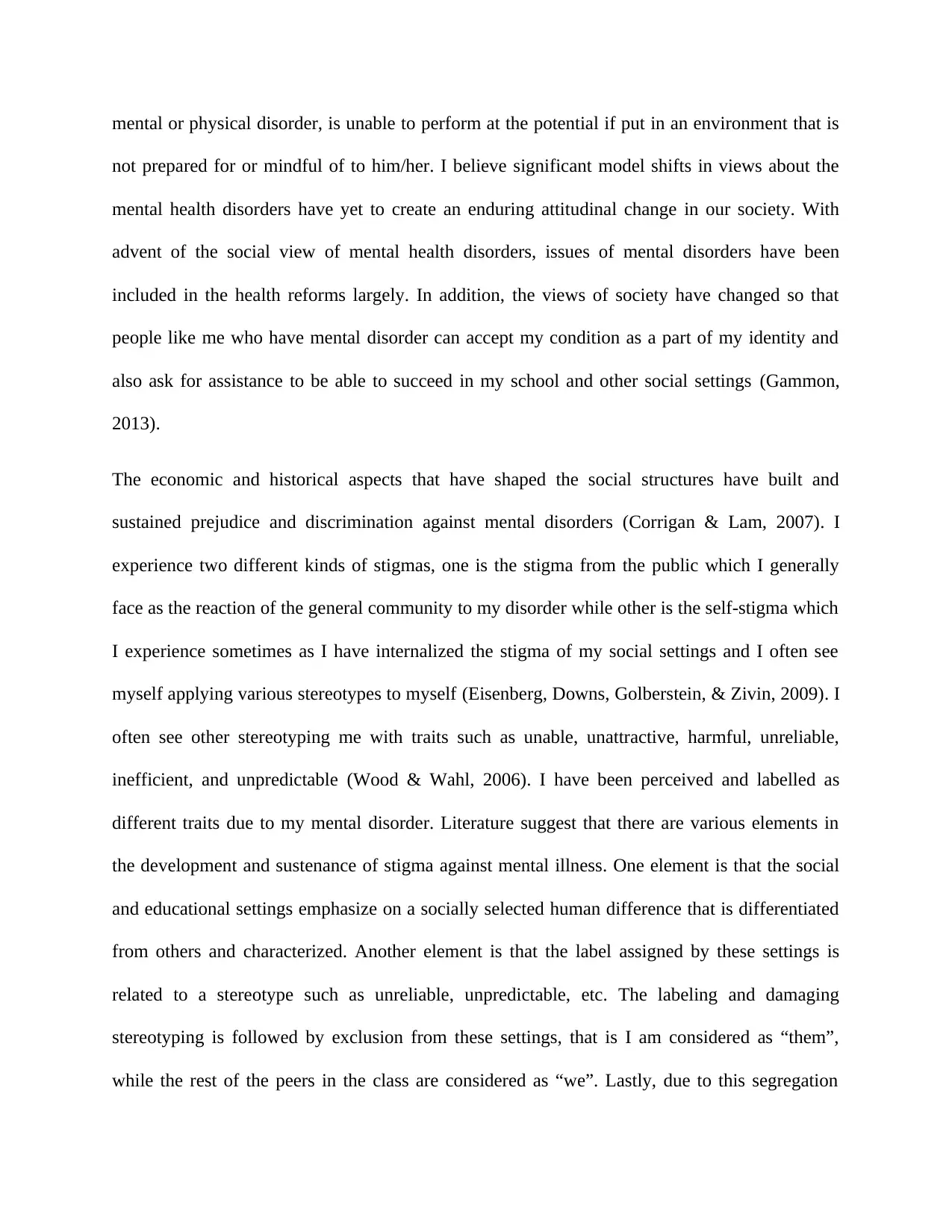
mental or physical disorder, is unable to perform at the potential if put in an environment that is
not prepared for or mindful of to him/her. I believe significant model shifts in views about the
mental health disorders have yet to create an enduring attitudinal change in our society. With
advent of the social view of mental health disorders, issues of mental disorders have been
included in the health reforms largely. In addition, the views of society have changed so that
people like me who have mental disorder can accept my condition as a part of my identity and
also ask for assistance to be able to succeed in my school and other social settings (Gammon,
2013).
The economic and historical aspects that have shaped the social structures have built and
sustained prejudice and discrimination against mental disorders (Corrigan & Lam, 2007). I
experience two different kinds of stigmas, one is the stigma from the public which I generally
face as the reaction of the general community to my disorder while other is the self-stigma which
I experience sometimes as I have internalized the stigma of my social settings and I often see
myself applying various stereotypes to myself (Eisenberg, Downs, Golberstein, & Zivin, 2009). I
often see other stereotyping me with traits such as unable, unattractive, harmful, unreliable,
inefficient, and unpredictable (Wood & Wahl, 2006). I have been perceived and labelled as
different traits due to my mental disorder. Literature suggest that there are various elements in
the development and sustenance of stigma against mental illness. One element is that the social
and educational settings emphasize on a socially selected human difference that is differentiated
from others and characterized. Another element is that the label assigned by these settings is
related to a stereotype such as unreliable, unpredictable, etc. The labeling and damaging
stereotyping is followed by exclusion from these settings, that is I am considered as “them”,
while the rest of the peers in the class are considered as “we”. Lastly, due to this segregation
not prepared for or mindful of to him/her. I believe significant model shifts in views about the
mental health disorders have yet to create an enduring attitudinal change in our society. With
advent of the social view of mental health disorders, issues of mental disorders have been
included in the health reforms largely. In addition, the views of society have changed so that
people like me who have mental disorder can accept my condition as a part of my identity and
also ask for assistance to be able to succeed in my school and other social settings (Gammon,
2013).
The economic and historical aspects that have shaped the social structures have built and
sustained prejudice and discrimination against mental disorders (Corrigan & Lam, 2007). I
experience two different kinds of stigmas, one is the stigma from the public which I generally
face as the reaction of the general community to my disorder while other is the self-stigma which
I experience sometimes as I have internalized the stigma of my social settings and I often see
myself applying various stereotypes to myself (Eisenberg, Downs, Golberstein, & Zivin, 2009). I
often see other stereotyping me with traits such as unable, unattractive, harmful, unreliable,
inefficient, and unpredictable (Wood & Wahl, 2006). I have been perceived and labelled as
different traits due to my mental disorder. Literature suggest that there are various elements in
the development and sustenance of stigma against mental illness. One element is that the social
and educational settings emphasize on a socially selected human difference that is differentiated
from others and characterized. Another element is that the label assigned by these settings is
related to a stereotype such as unreliable, unpredictable, etc. The labeling and damaging
stereotyping is followed by exclusion from these settings, that is I am considered as “them”,
while the rest of the peers in the class are considered as “we”. Lastly, due to this segregation
Secure Best Marks with AI Grader
Need help grading? Try our AI Grader for instant feedback on your assignments.
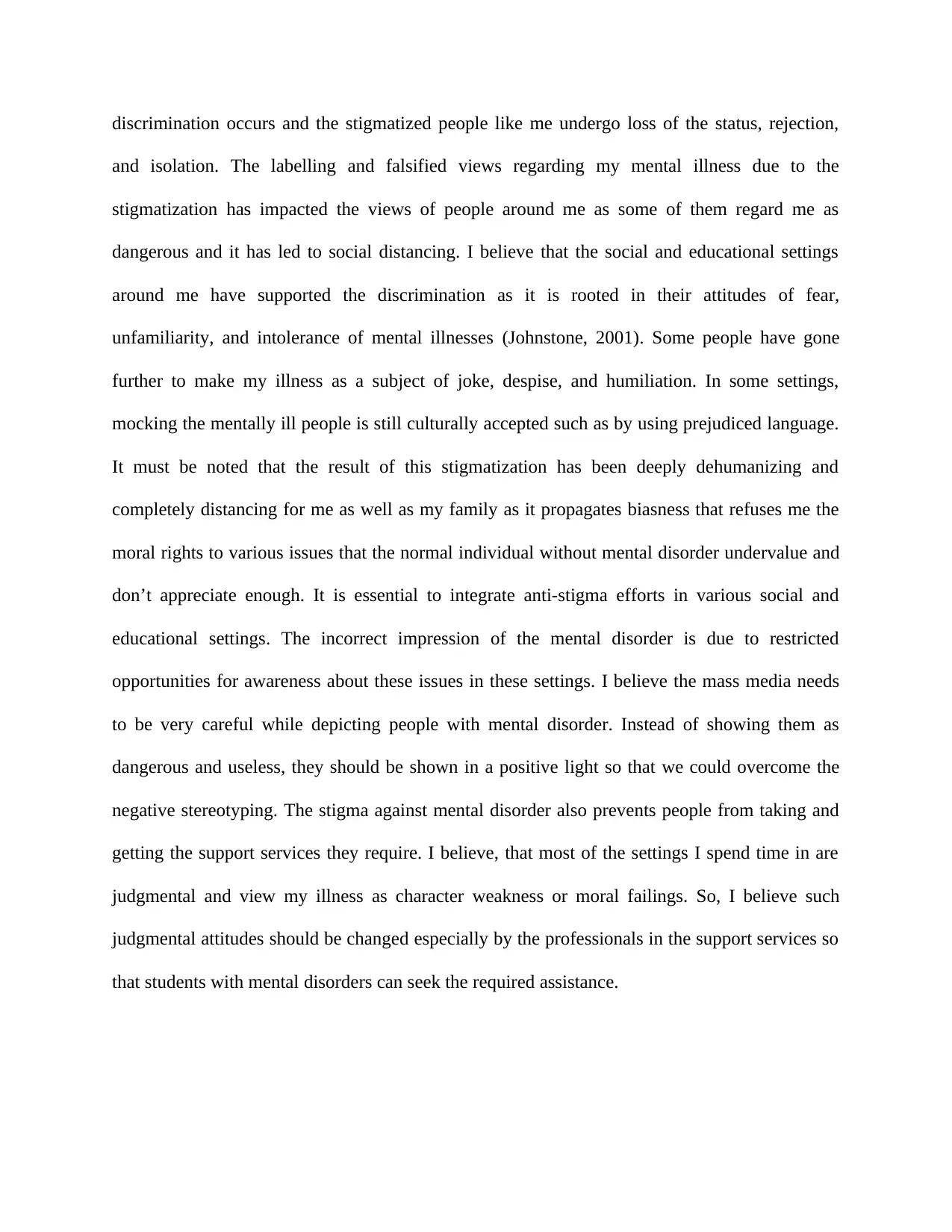
discrimination occurs and the stigmatized people like me undergo loss of the status, rejection,
and isolation. The labelling and falsified views regarding my mental illness due to the
stigmatization has impacted the views of people around me as some of them regard me as
dangerous and it has led to social distancing. I believe that the social and educational settings
around me have supported the discrimination as it is rooted in their attitudes of fear,
unfamiliarity, and intolerance of mental illnesses (Johnstone, 2001). Some people have gone
further to make my illness as a subject of joke, despise, and humiliation. In some settings,
mocking the mentally ill people is still culturally accepted such as by using prejudiced language.
It must be noted that the result of this stigmatization has been deeply dehumanizing and
completely distancing for me as well as my family as it propagates biasness that refuses me the
moral rights to various issues that the normal individual without mental disorder undervalue and
don’t appreciate enough. It is essential to integrate anti-stigma efforts in various social and
educational settings. The incorrect impression of the mental disorder is due to restricted
opportunities for awareness about these issues in these settings. I believe the mass media needs
to be very careful while depicting people with mental disorder. Instead of showing them as
dangerous and useless, they should be shown in a positive light so that we could overcome the
negative stereotyping. The stigma against mental disorder also prevents people from taking and
getting the support services they require. I believe, that most of the settings I spend time in are
judgmental and view my illness as character weakness or moral failings. So, I believe such
judgmental attitudes should be changed especially by the professionals in the support services so
that students with mental disorders can seek the required assistance.
and isolation. The labelling and falsified views regarding my mental illness due to the
stigmatization has impacted the views of people around me as some of them regard me as
dangerous and it has led to social distancing. I believe that the social and educational settings
around me have supported the discrimination as it is rooted in their attitudes of fear,
unfamiliarity, and intolerance of mental illnesses (Johnstone, 2001). Some people have gone
further to make my illness as a subject of joke, despise, and humiliation. In some settings,
mocking the mentally ill people is still culturally accepted such as by using prejudiced language.
It must be noted that the result of this stigmatization has been deeply dehumanizing and
completely distancing for me as well as my family as it propagates biasness that refuses me the
moral rights to various issues that the normal individual without mental disorder undervalue and
don’t appreciate enough. It is essential to integrate anti-stigma efforts in various social and
educational settings. The incorrect impression of the mental disorder is due to restricted
opportunities for awareness about these issues in these settings. I believe the mass media needs
to be very careful while depicting people with mental disorder. Instead of showing them as
dangerous and useless, they should be shown in a positive light so that we could overcome the
negative stereotyping. The stigma against mental disorder also prevents people from taking and
getting the support services they require. I believe, that most of the settings I spend time in are
judgmental and view my illness as character weakness or moral failings. So, I believe such
judgmental attitudes should be changed especially by the professionals in the support services so
that students with mental disorders can seek the required assistance.
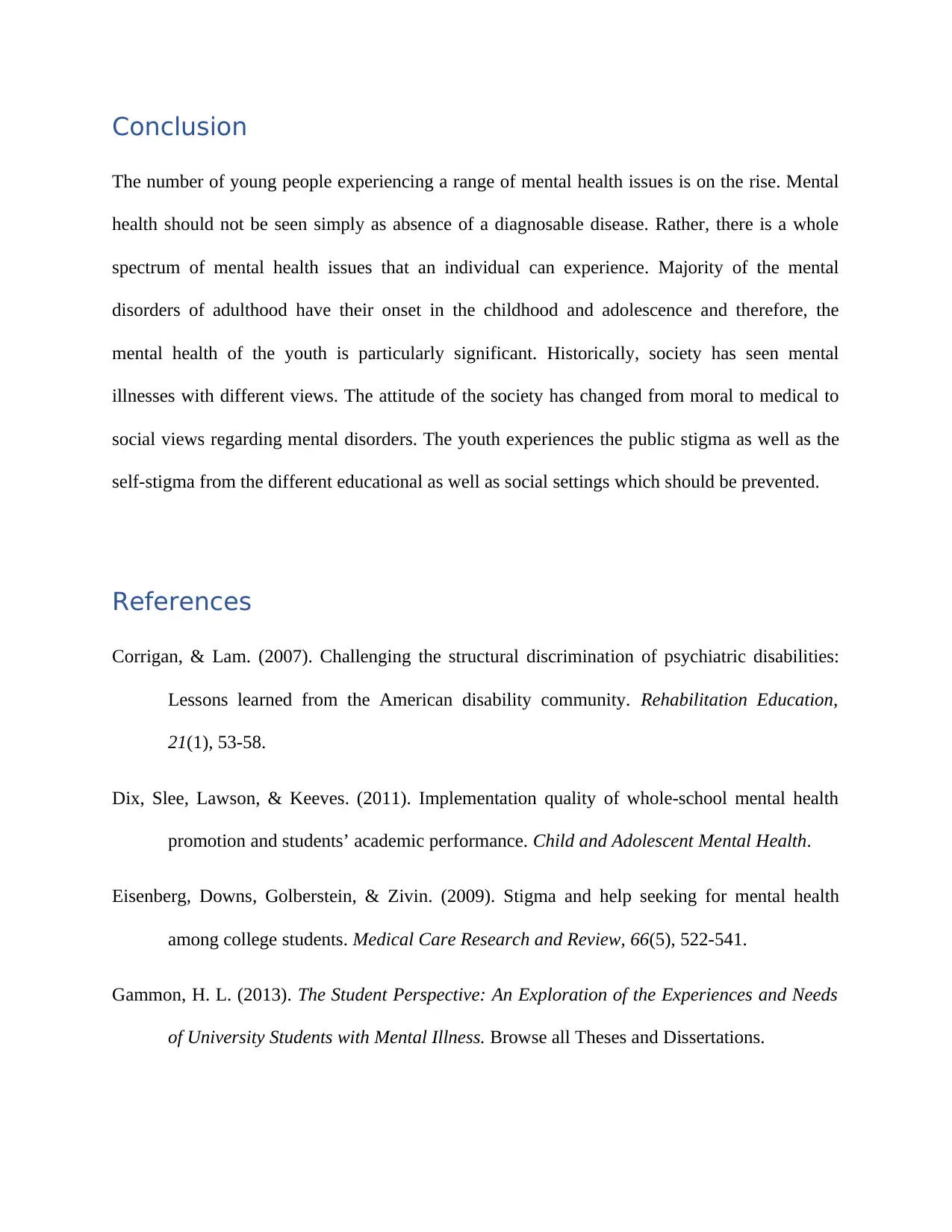
Conclusion
The number of young people experiencing a range of mental health issues is on the rise. Mental
health should not be seen simply as absence of a diagnosable disease. Rather, there is a whole
spectrum of mental health issues that an individual can experience. Majority of the mental
disorders of adulthood have their onset in the childhood and adolescence and therefore, the
mental health of the youth is particularly significant. Historically, society has seen mental
illnesses with different views. The attitude of the society has changed from moral to medical to
social views regarding mental disorders. The youth experiences the public stigma as well as the
self-stigma from the different educational as well as social settings which should be prevented.
References
Corrigan, & Lam. (2007). Challenging the structural discrimination of psychiatric disabilities:
Lessons learned from the American disability community. Rehabilitation Education,
21(1), 53-58.
Dix, Slee, Lawson, & Keeves. (2011). Implementation quality of whole-school mental health
promotion and students’ academic performance. Child and Adolescent Mental Health.
Eisenberg, Downs, Golberstein, & Zivin. (2009). Stigma and help seeking for mental health
among college students. Medical Care Research and Review, 66(5), 522-541.
Gammon, H. L. (2013). The Student Perspective: An Exploration of the Experiences and Needs
of University Students with Mental Illness. Browse all Theses and Dissertations.
The number of young people experiencing a range of mental health issues is on the rise. Mental
health should not be seen simply as absence of a diagnosable disease. Rather, there is a whole
spectrum of mental health issues that an individual can experience. Majority of the mental
disorders of adulthood have their onset in the childhood and adolescence and therefore, the
mental health of the youth is particularly significant. Historically, society has seen mental
illnesses with different views. The attitude of the society has changed from moral to medical to
social views regarding mental disorders. The youth experiences the public stigma as well as the
self-stigma from the different educational as well as social settings which should be prevented.
References
Corrigan, & Lam. (2007). Challenging the structural discrimination of psychiatric disabilities:
Lessons learned from the American disability community. Rehabilitation Education,
21(1), 53-58.
Dix, Slee, Lawson, & Keeves. (2011). Implementation quality of whole-school mental health
promotion and students’ academic performance. Child and Adolescent Mental Health.
Eisenberg, Downs, Golberstein, & Zivin. (2009). Stigma and help seeking for mental health
among college students. Medical Care Research and Review, 66(5), 522-541.
Gammon, H. L. (2013). The Student Perspective: An Exploration of the Experiences and Needs
of University Students with Mental Illness. Browse all Theses and Dissertations.
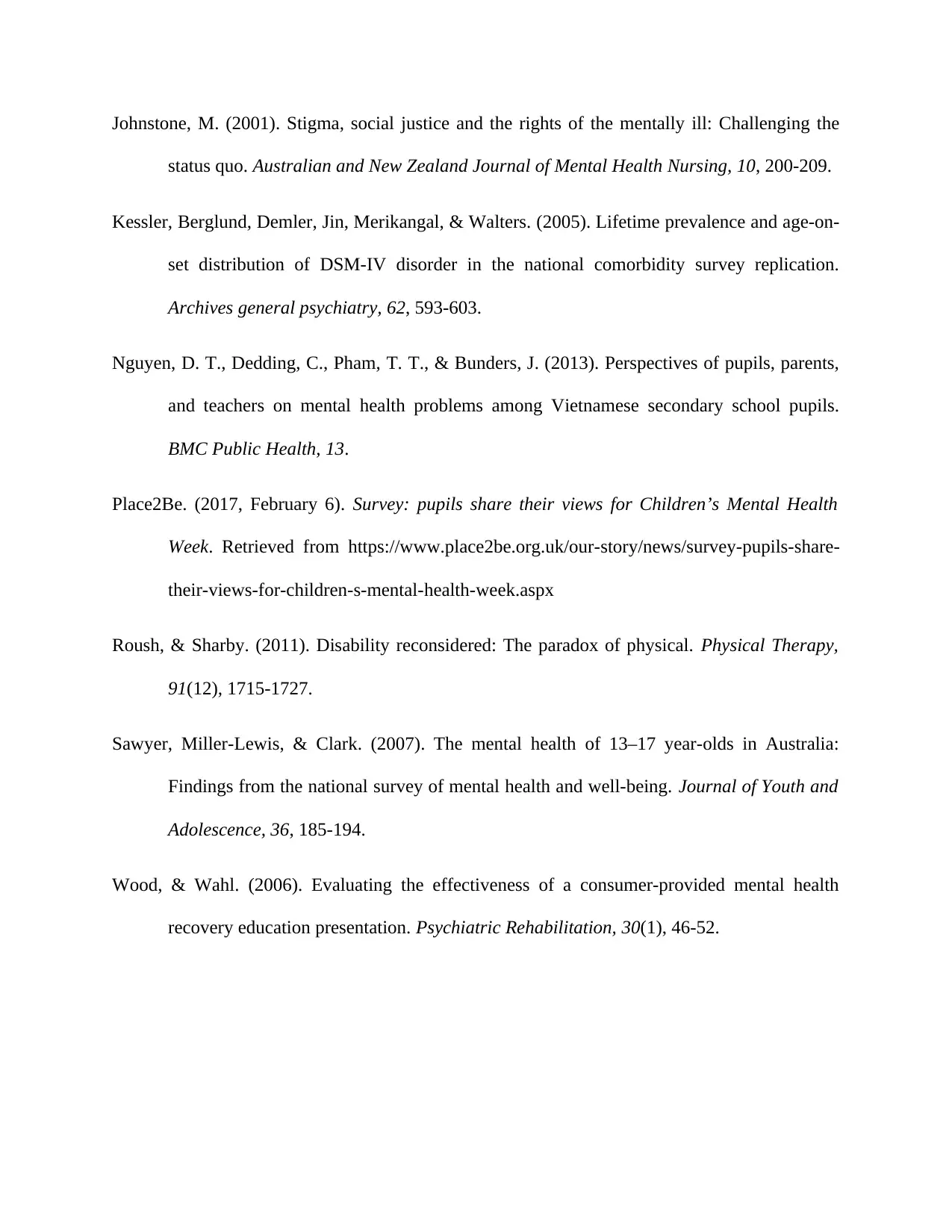
Johnstone, M. (2001). Stigma, social justice and the rights of the mentally ill: Challenging the
status quo. Australian and New Zealand Journal of Mental Health Nursing, 10, 200-209.
Kessler, Berglund, Demler, Jin, Merikangal, & Walters. (2005). Lifetime prevalence and age-on-
set distribution of DSM-IV disorder in the national comorbidity survey replication.
Archives general psychiatry, 62, 593-603.
Nguyen, D. T., Dedding, C., Pham, T. T., & Bunders, J. (2013). Perspectives of pupils, parents,
and teachers on mental health problems among Vietnamese secondary school pupils.
BMC Public Health, 13.
Place2Be. (2017, February 6). Survey: pupils share their views for Children’s Mental Health
Week. Retrieved from https://www.place2be.org.uk/our-story/news/survey-pupils-share-
their-views-for-children-s-mental-health-week.aspx
Roush, & Sharby. (2011). Disability reconsidered: The paradox of physical. Physical Therapy,
91(12), 1715-1727.
Sawyer, Miller-Lewis, & Clark. (2007). The mental health of 13–17 year-olds in Australia:
Findings from the national survey of mental health and well-being. Journal of Youth and
Adolescence, 36, 185-194.
Wood, & Wahl. (2006). Evaluating the effectiveness of a consumer-provided mental health
recovery education presentation. Psychiatric Rehabilitation, 30(1), 46-52.
status quo. Australian and New Zealand Journal of Mental Health Nursing, 10, 200-209.
Kessler, Berglund, Demler, Jin, Merikangal, & Walters. (2005). Lifetime prevalence and age-on-
set distribution of DSM-IV disorder in the national comorbidity survey replication.
Archives general psychiatry, 62, 593-603.
Nguyen, D. T., Dedding, C., Pham, T. T., & Bunders, J. (2013). Perspectives of pupils, parents,
and teachers on mental health problems among Vietnamese secondary school pupils.
BMC Public Health, 13.
Place2Be. (2017, February 6). Survey: pupils share their views for Children’s Mental Health
Week. Retrieved from https://www.place2be.org.uk/our-story/news/survey-pupils-share-
their-views-for-children-s-mental-health-week.aspx
Roush, & Sharby. (2011). Disability reconsidered: The paradox of physical. Physical Therapy,
91(12), 1715-1727.
Sawyer, Miller-Lewis, & Clark. (2007). The mental health of 13–17 year-olds in Australia:
Findings from the national survey of mental health and well-being. Journal of Youth and
Adolescence, 36, 185-194.
Wood, & Wahl. (2006). Evaluating the effectiveness of a consumer-provided mental health
recovery education presentation. Psychiatric Rehabilitation, 30(1), 46-52.
1 out of 10
Related Documents
Your All-in-One AI-Powered Toolkit for Academic Success.
+13062052269
info@desklib.com
Available 24*7 on WhatsApp / Email
![[object Object]](/_next/static/media/star-bottom.7253800d.svg)
Unlock your academic potential
© 2024 | Zucol Services PVT LTD | All rights reserved.